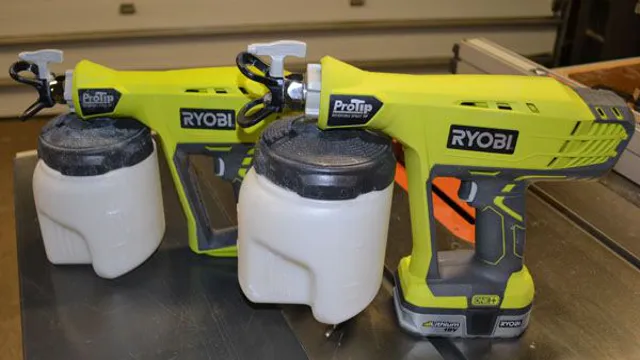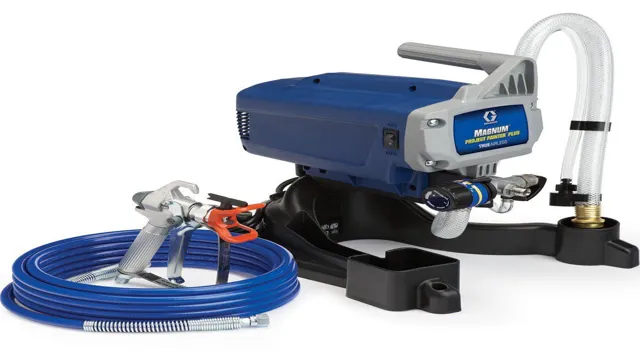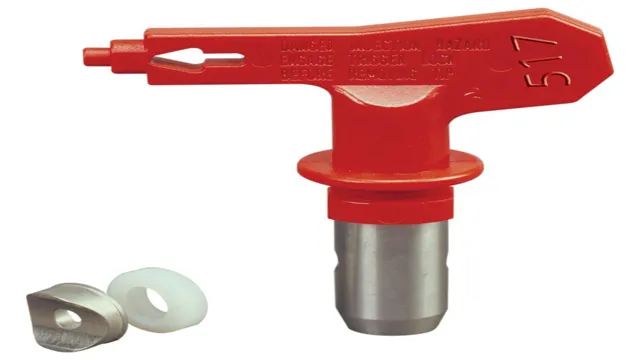How to Use Ryobi Paint Sprayer: Tips and Tricks for Efficient Paint Application

Are you tired of painting walls and furniture by hand? Do you want a faster and more efficient way to get your painting projects done? Look no further than the Ryobi paint sprayer! This handy tool provides you with a professional finish while also saving you time and effort. Imagine being able to complete your painting projects in a fraction of the time it would take with a brush or roller. The Ryobi paint sprayer is easy to use, and with a little practice, you can become a pro in no time.
Think of it as a magic wand that transforms your home or workspace with a simple wave. In this blog post, we’ll go over some tips and tricks for using your Ryobi paint sprayer to achieve the best results possible. Let’s dive in!
Preparation
If you want to know how to use a Ryobi paint sprayer like a pro, preparation is key. First, you’ll need to choose the right paint for your project and ensure it’s properly thinned if necessary. Then, you’ll want to protect the surrounding area with drop cloths or plastic sheeting to avoid any unintended splatters or drips.
Make sure your sprayer is properly assembled and cleaned beforehand as well. Next, take the time to mask off any areas that you don’t want to paint, such as trim or windows. Finally, test the spray pattern on a piece of cardboard before starting on your project to ensure you have the right pressure and flow settings.
Proper preparation is essential to achieving a smooth and even finish with your Ryobi paint sprayer.
Mask off the Area
Preparing for a painting project can be just as important as the actual painting process. One essential step is to mask off the area you’ll be working on. Masking off the area helps to protect surfaces that you don’t want to be painted.
The first thing to do is to clear everything out of the room that you can. If some items can’t be moved, then cover them with a plastic drop cloth or a sheet. Next, use painter’s tape to outline the edges of the area you’ll be painting.
Be sure to apply the tape firmly and smooth out any wrinkles or bubbles. It’s also important to cover any remaining areas, such as baseboards or light fixtures, with tape or plastic. Taking the time to mask off the area properly will help ensure a clean and professional-looking paint job.
Remember, taking a few extra minutes to prepare can save you time and hassle in the long run.

Prepare the Paint
Preparing the paint is an essential step in any painting project to ensure that the surface is clean and ready for the paint. The first step in preparing the paint is to gather all the necessary tools such as sandpaper, paint scraper, and cleaning supplies. Begin by sanding the surface with a medium-grit sandpaper to remove any loose paint, rust, or debris.
Next, use a paint scraper to remove any chipped or peeling paint. Once the surface is smooth, wipe it off with a clean cloth and cleaning solution to remove dirt and grime. If there are any holes or cracks in the surface, fill them with joint compound, let it dry, and sand it again.
Finally, apply a coat of primer to the surface, which will ensure that the paint adheres properly to the surface and lasts longer. Following these steps will ensure a smooth, long-lasting paint job.
Fill the Sprayer with Paint
When it comes to painting with a sprayer, preparation is key to achieving a flawless finish. One of the essential steps in getting started with your sprayer is filling it up with paint. Before you start pouring paint into your sprayer, it’s important to read the manufacturer’s instructions carefully to determine the best type of paint to use for your project.
Once you’ve gathered all the necessary supplies, you’ll want to ensure that your workspace is clean and free of any debris that could potentially contaminate your paint. A tip for filling up your sprayer is to strain your paint through a fine mesh strainer to remove any lumps or impurities. Make sure to fill the sprayer with the recommended amount of paint, and then test your sprayer on a piece of cardboard or scrap material to ensure that the paint is being applied evenly.
With a little bit of preparation, you’ll be ready to start painting with your sprayer in no time.
Prime the Sprayer
Before starting to spray, it’s essential to prepare the paint sprayer. One of the first things you need to do is prime the sprayer. Priming ensures that the paint flows smoothly through the system and prevents any blockages or mishaps during the painting process.
To prime the sprayer, fill it with some clean water and pump it through the system to clear any debris or dust that might have accumulated. Once the water runs clear, you can proceed to add the paint to the sprayer and prime it again. Always follow the manufacturer’s instructions and recommendations on how to prime the sprayer, as different models may require different procedures.
Although it may add a few extra minutes to the paint job, priming is a necessary and simple step that can save you plenty of time and stress in the long run. Just imagine, starting a project only to have the sprayer clog and needing to start over. By taking the time to prime the sprayer, you’re ensuring the smoothest painting experience possible.
Usage
If you’re wondering how to use the Ryobi paint sprayer, rest assured that it’s a pretty straightforward process. First things first, make sure you have all the necessary materials, including the paint sprayer, paint, and any safety equipment like goggles and a mask. Then, prepare the area by covering any nearby furniture or flooring with drop cloths.
Next, fill the sprayer with paint according to the manufacturer’s instructions and adjust the spray pattern and pressure as desired. When you’re ready to start spraying, hold the sprayer nozzle approximately 6-8 inches away from the surface you’ll be painting and move your hand in a steady back-and-forth motion. Be sure to work in small sections and overlap each stroke slightly to ensure full coverage.
Once you’re finished, clean the sprayer thoroughly using water or the recommended cleaning solution. With a little practice, you’ll be a pro at using the Ryobi paint sprayer in no time!
Hold the Sprayer Correctly
When it comes to using a sprayer, it’s important to hold it correctly to ensure proper application and avoid any accidents. The first thing to keep in mind is to hold the sprayer with both hands and make sure you have a firm grip. This will not only help in staying in control, but also prevent any unnecessary strain on your hands.
Secondly, avoid pointing the sprayer directly at yourself or others as it can be dangerous and cause harm. Always aim it away from your body and towards the area you need to spray. Finally, adjust the nozzle of the sprayer depending on your needs.
Whether you need a wider or a smaller spray pattern, make sure the nozzle is adjusted accordingly. By holding the sprayer correctly, you can ensure an effective and efficient spraying experience while staying safe at the same time.
Start Spraying
Now that you have your trusty pest control spray in hand, it’s time to start using it to get rid of those pesky insects once and for all. But before you begin, make sure to read the label carefully and follow the instructions closely. Most sprays require you to shake the bottle well before use and hold it about 12 inches away from the surface you wish to spray.
Be sure to wear gloves and a mask to protect yourself from any potential harm. When spraying, move the bottle slowly back and forth to ensure even coverage and pay special attention to any areas that insects tend to frequent. Once you’re finished, be sure to store the spray in a cool, dry place away from children and pets.
With proper usage, your pest control spray can help you maintain a bug-free environment in your home or garden.
Adjust the Spray Pattern
Adjusting the spray pattern of your irrigation system is a crucial part of ensuring efficient usage. It can help you avoid wastage and save water while providing the right amount of moisture to your plants. The process of adjusting the spray pattern involves changing the angle and radius of the sprinkler head.
This can be done manually or by using a nozzle that allows you to adjust the pattern according to your needs. By adjusting the spray pattern, you can ensure that your plants get the water they need, and you can avoid watering areas that don’t require it. It can also help you save money on your water bills, especially if you have a large garden or farm to irrigate.
So, take the time to adjust the spray pattern of your sprinklers or nozzles regularly, and you’ll see the benefits in healthier plants and a more efficient irrigation system.
Cleaning Up
Cleaning up after using a Ryobi paint sprayer is an important step to maintain the longevity of your equipment and ensure any paint residue is removed from your workspace. Firstly, turn off your sprayer and remove any remaining paint from the container, then add warm water to the container and spray it through the nozzle to flush out any remaining paint. To fully clean the sprayer, disassemble the parts and use soap and warm water to clean them.
For stubborn paint residue, use a paintbrush to gently scrub the parts. After cleaning, dry the parts thoroughly before storing them in a dry and secure location. Following these steps will ensure that your Ryobi paint sprayer remains in tip-top condition for your next painting project.
Remove Excess Paint
When you are finished painting, it’s important to clean up any excess paint in order to keep your tools in good shape and avoid any messes. You can start by wiping off any excess paint on the rim of your paint can or your brush onto a piece of cardboard. Another useful tool is a paint key, which is a small device that helps remove excess paint from paintbrushes.
Afterward, you can use soap and water to clean your brushes and roller, making sure to rinse them thoroughly and gently reshape the bristles. For quicker cleanup, you can use disposable paint tray liners and rollers. Remember, by taking the time to properly clean up after painting, you’ll be able to extend the life of your tools and continue to produce quality work.
Flush out the Sprayer
When it comes to using a sprayer, it’s important to keep it well-maintained in order to ensure consistent performance. One key step in this maintenance process is to flush out the sprayer regularly. This means removing any leftover chemicals or paint from the system in order to prevent blockages or other issues from arising.
To start the flushing process, you’ll want to first empty any remaining liquid from the sprayer and then fill it with clean water. Next, run the sprayer for a few minutes to allow the water to pass through the system and remove any excess chemical residue. You may need to repeat this process several times, depending on the type of sprayer you’re using and the types of materials you’ve been spraying.
By taking the time to properly flush out your sprayer, you can help ensure that it will continue to perform like new for years to come.
Store the Sprayer Safely
After a long day of spraying, it can be tempting to just leave your sprayer outside and deal with it later. However, storing your sprayer safely is essential to its longevity and effectiveness. The first step in cleaning up your sprayer is to empty any remaining chemical mixtures, dispose of them properly, and rinse out the tank thoroughly.
Make sure to wear appropriate protective gear and follow the manufacturer’s instructions for cleaning. After the tank is clean, detach any removable parts such as nozzles and screens, and clean them separately. Once everything is clean and dry, store your sprayer in a cool, dry place where it won’t be exposed to extreme temperatures or humidity.
If you’re storing it for an extended period of time, consider adding some rust inhibitor to prevent corrosion. By taking the time to properly clean and store your sprayer, you’ll avoid costly repairs and replacements down the road.
Conclusion
In conclusion, using the Ryobi paint sprayer may seem intimidating at first, but with a little patience and practice, you’ll be painting like a pro in no time. It’s important to follow the instructions carefully, choose the right tip size for your project, and adjust the spray pattern and flow to your desired level. And always remember: with great power comes great responsibility – so be sure to protect your surfaces and wear proper safety gear.
Happy painting!”
FAQs
What is the benefit of using a Ryobi paint sprayer?
The benefit of using a Ryobi paint sprayer is that it can produce a more uniform and consistent coat of paint, with less time and effort than using a brush or roller.
Can a Ryobi paint sprayer be used with any type of paint?
Yes, a Ryobi paint sprayer can typically be used with most types of paint, including latex, oil-based, and stain.
How do you clean a Ryobi paint sprayer after use?
After use, the Ryobi paint sprayer should be cleaned by flushing the system with water or a cleaning solution, depending on the type of paint used. The spray gun and nozzle should also be thoroughly cleaned and dried.
Can the spray pattern be adjusted on a Ryobi paint sprayer?
Yes, the spray pattern on a Ryobi paint sprayer can generally be adjusted to accommodate different surfaces and coatings, such as a wider fan for large surfaces or a more concentrated stream for detailed work.
How much paint can a Ryobi paint sprayer hold?
The paint cup on a Ryobi paint sprayer can typically hold up to 1 quart of paint, which should be sufficient for most small to medium-sized projects.
Is it necessary to thin the paint before using a Ryobi paint sprayer?
Depending on the type and consistency of the paint, it may be necessary to thin it before using a Ryobi paint sprayer. Check the manufacturer’s instructions for guidance on thinning ratios.
Can a Ryobi paint sprayer be used for automotive painting?
Yes, a Ryobi paint sprayer can be used for automotive painting, although it may require additional accessories or modifications for certain applications. Always check the manufacturer’s instructions and guidelines before using any paint sprayer for automotive work.


